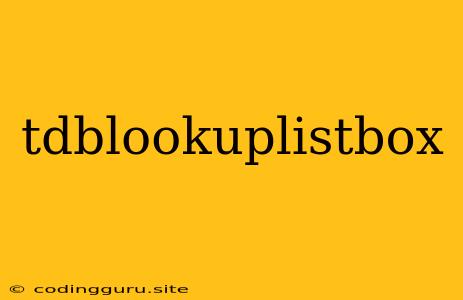Understanding and Utilizing the TDBLookupListBox Control in Delphi
The TDBLookupListBox is a powerful control in Delphi that provides a user-friendly way to select values from a database table and display them in a list box. It's a versatile tool for data entry and manipulation, enabling you to streamline data selection processes within your applications.
What is a TDBLookupListBox?
The TDBLookupListBox is a visual component designed to simplify the process of selecting data from a database table. It seamlessly integrates with Delphi's data-aware components, allowing you to connect it directly to a database table and display a list of values. Users can then easily select the desired value from the list box.
How Does it Work?
The TDBLookupListBox works by establishing a connection to a database table. You define a DataSource and a DataSet to specify the table and the fields you want to display. When the control is populated, it fetches data from the specified table, creating a list of available options for the user to choose from.
Key Features of TDBLookupListBox
- Data Binding: It directly connects to a data source and automatically displays the specified fields from the associated database table.
- User-Friendly Interface: The list box format provides a clear and intuitive way for users to select values.
- Customizable Appearance: You can control the appearance of the list box, including its size, font, and colors.
- Data Validation: You can implement data validation rules to ensure that only valid entries are allowed in the TDBLookupListBox.
- Data Storage: The control automatically stores the selected value in the associated database field.
Common Uses of TDBLookupListBox
- Data Entry Forms: It simplifies data entry processes by presenting a list of valid options for fields like "State", "Country", "Product Category", and more.
- Lookup Functionality: Users can efficiently search and select values from a table, improving user experience and accuracy.
- Dropdown Menus: The TDBLookupListBox can be customized to function as a dropdown menu, providing a compact and user-friendly selection method.
- Filtering and Sorting: You can use it to filter and sort the displayed list of options based on specific criteria, making it easier for users to find the desired information.
Example: Implementing TDBLookupListBox for Data Entry
Let's illustrate the use of TDBLookupListBox with an example. Imagine you are building a customer database application in Delphi. You need to allow users to select a customer's state from a list of available states. Here's how you can implement this functionality using TDBLookupListBox:
- Database Setup: Create a table named "States" with a field called "StateName". Populate this table with a list of states.
- Place the Control: Place a TDBLookupListBox component on your form.
- Data Binding:
- Set the DataSource property of the TDBLookupListBox to a valid TDataSource component connected to your database.
- Set the DataSet property to the TDataSet that represents your "States" table.
- Set the ListField property to the "StateName" field in the "States" table.
- Run the Application: The TDBLookupListBox will now display a list of states from your database, allowing users to easily select the appropriate state.
Tips for Effective TDBLookupListBox Use
- Data Validation: Implement validation rules to ensure that the user selects a valid value from the list box.
- Customizing Appearance: Adjust the appearance of the control to match your application's design.
- Performance Optimization: For large datasets, consider caching data to improve the control's performance.
- Error Handling: Implement error handling mechanisms to gracefully manage potential errors during data retrieval.
Conclusion
The TDBLookupListBox is a valuable component in Delphi that simplifies database interaction by providing a user-friendly way to select values from a table. Its versatility, ease of use, and flexibility make it an essential tool for developers building applications with data-driven functionality. By utilizing its features effectively, you can enhance the usability and data integrity of your applications.
